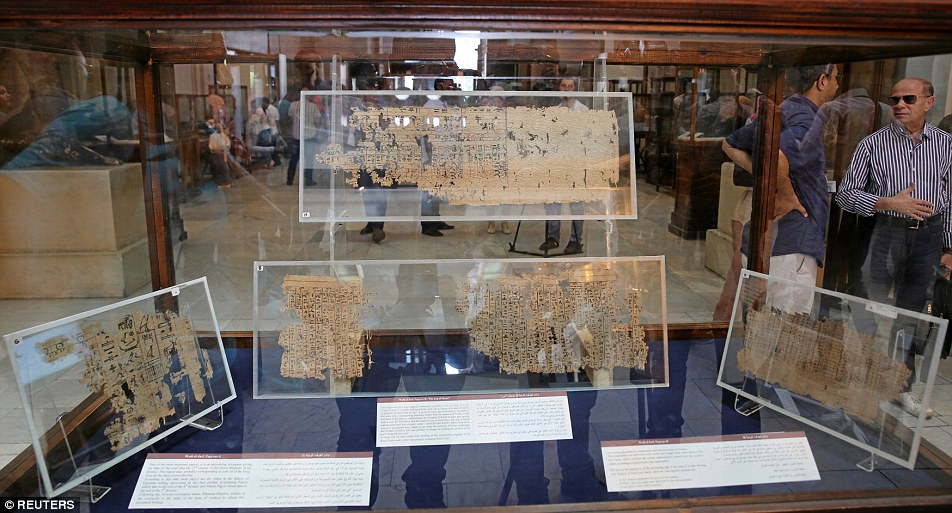The Great Pyramids of Giza has been one of the world’s greatest enigmas—how did an ancient society build such massive monuments without the help of modern machinery? The first and the largest of them, the Pyramid of Khufu, is 146 meters tall and until about 800 years ago, it was the tallest man-made structure on Earth. The mystery of the pyramids would perhaps never be solved in entirety, but certain discoveries have helped us understand how some of the impossibilities might have been achieved.

One such discovery was made in 2013 at a site called Wadi al-Jarf, which was an old harbor on the Red Sea coast. While excavating some drystone buildings and man-made caves which was used to store wooden boats, archeologists Pierre Tallet and Gregory Marouard discovered entire rolls of papyrus, some a few feet long and others in fragments. They were written in hieroglyphics as well as hieratic, which was the cursive script the ancient Egyptians used for everyday communication. Some of the papyri were even dated to “The year after the 13th cattle count” of King Khufu, meaning around year 26 or 27 of his reign. This makes them the oldest papyrus documents yet found.
Even more astonishing was that the papyri were written by men who participated in the building of the Great Pyramid. Some of them were book of accounts, which detailed the movement of bread, beer, cereals and meat to feed the 20,000-strong workforce spread across the pyramid site, quarries and transport teams. “The documents are laid out like a modern spreadsheet, showing what was needed, what had been delivered and what was still owed,” as per History Today.

Papyrus containing the diary of Merer at the Wadi al-Jarf exhibition, Cairo Museum, 2016.
Others were journals, detailing the activities on a daily basis. Among these was one written by an “inspector” named Merer, who led a crew of some 200 men who traveled from one end of Egypt to the other picking up and delivering goods of one kind or another. Their main work was transporting limestone blocks from the quarries of ‘Ro-Au’ (Tura) to the site at Giza about 15-20 km away. We already know that the pharaohs used limestone from Tura, a town along the Nile famous for its limestone quarry, to provide for the pyramids’ outer casing, which has since been striped away exposing the roughly hewn granite blocks that are visible today. Merer’s journal thus chronicles the last known year of Khufu’s reign, when the ancient Egyptians were putting finishing touches on the Great Pyramid.
Merer’s records describe his crew hauling stones at Tura, filling his boats with stone and taking it up the Nile River to Giza. The trip took two days. The unladen return trip took only one day. The crew completed a round-trip between Giza and the quarries at Tura two or three times in each ten-day Egyptian week. This could only have taken place around the time of the yearly flood, when the high waters of the Nile made it more navigable for heavily laden vessels. It has been calculated that the boats could have carried a load of 70-80 tons, or about 30 of the 2.5 ton blocks used to clad the pyramid of Khufu. This means that Merer’s team would have moved around 200 blocks a month, up to 1,000 in the period when the river and canals were navigable.

Papyrus containing the diary of Merer at the Wadi al-Jarf exhibition, Cairo Museum, 2016.
Merer also mentions reporting to “the noble Ankh-haf,” serving as the Director of ‘the entrance to the Pool of Khufu’, probably an artificial lake, used as a staging post on the northbound journey from Tura to the Giza Plateau. Ankhhaf was Khufu’s half-brother and apparently the pyramid’s project manager during its completion. This was the first time a definitive person was identified as overseeing some of the construction of the Great Pyramid. The diary also mentions the original name of the Great Pyramid—Akhet-Khufu, meaning “Horizon of Khufu.”
Zahi Hawass, the Egyptian archaeologist, and formerly the chief inspector of the pyramid site and minister of antiquities, says that it is “the greatest discovery in Egypt in the 21st century.”
“Merer and Dedi’s records help us to flesh out the geography of lower Egypt and the network of canals and harbours that enabled the movement of stones, workers and supplies to the pyramid site,” writes Egyptologist Dan Potter. “The teams were highly skilled and versatile, not only moving material for the pyramid and temples, but also engaging in storehouse management, potentially constructing a dock in the Delta and taking part in mining missions to Sinai,”

Papyrus containing the diary of Merer at the Wadi al-Jarf exhibition, Cairo Museum, 2016.
It is believed that the notebooks and the accounts books were left behind at Wadi al-Jarf after the crew’s final assignment. “I imagine because of the death of the king.. they just stopped everything and closed up the galleries and then as they were leaving buried the archives in the area between the two large stones used to seal the complex. The date on the papyri seems to be the last date we have for the reign of Khufu, the 27th year of his reign,” says Pierre Tallet.
After the site was closed operations under Khufu’s successor, Khafre, took place at Ain Sukhna to the north.
References:
# The World’s Oldest Papyrus and What It Can Tell Us About the Great Pyramids, Smithsonian Magazine
# Monumental Record, History Today












Comments
Post a Comment